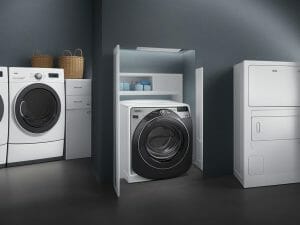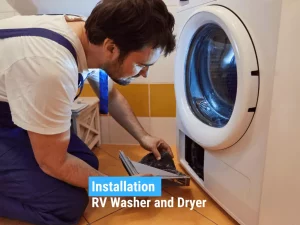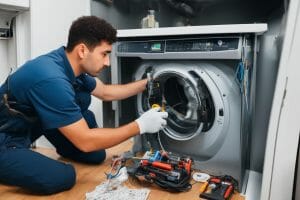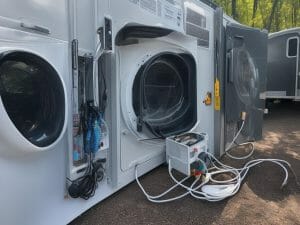Troubleshooting Common RV Washer and Dryer Problems
Are you tired of your RV washer and dryer causing you endless frustration? Don’t worry, we’ve got you covered!
In this article, we will guide you through troubleshooting common problems with your RV washer and dryer. From deciphering error codes to fixing drainage issues, we’ll show you step-by-step solutions to get your laundry routine back on track.
Say goodbye to wet clothes and strange noises – with our help, your RV washer and dryer will be running smoothly in no time.
So, let’s dive in and make your RV feel like home sweet home!
Key Takeaways
Error Codes and Their Meanings

If your RV washer and dryer display error codes, it’s important to understand their meanings to effectively troubleshoot the issue. Error codes are designed to provide specific information about the problem at hand.
By familiarizing yourself with these error codes and their meanings, you can quickly identify the root cause and take appropriate action.
Common causes of error codes in RV washers and dryers include issues with water supply, drainage, electrical connections, or mechanical failures. For example, the E1 error code usually indicates a problem with the water supply, while the E2 error code suggests a drainage issue.
Washer Not Draining Properly
Check if the drain hose is clogged or kinked, as this can prevent the washer from draining properly. Improper drainage is a common issue with RV washers, but don’t worry, and there are solutions.
First, inspect the drain hose for any obstructions or twists. If you find any, straighten the hose and remove any debris.
Next, check the drain pump for any signs of blockage. Clear any debris that may be hindering the pump’s functionality.
If the hose and pump are clear, the problem may lie with the drain filter. Remove the filter and clean it thoroughly.
Once everything is cleaned and cleared, test the washer to ensure proper drainage. By troubleshooting the washer not draining issue, you can maintain the functionality of your RV washer and dryer.
Dryer Not Heating up
If your dryer is not heating up, there are two key points to consider: a faulty heating element or a clogged ventilation system.
A faulty heating element can prevent the dryer from producing enough heat to effectively dry your clothes.
On the other hand, a clogged ventilation system can restrict the flow of air, causing the dryer to overheat and fail to generate enough heat.
To resolve these issues, you may need to replace the heating element or clean out the ventilation system to ensure proper airflow.
Faulty Heating Element
Make sure to double-check that your RV washer and dryer’s heating element is functioning properly. If you’re experiencing issues with the heating element, here are some troubleshooting steps to help you identify and resolve the problem:
- Check for power supply: Ensure that your RV is receiving a steady power supply. Faulty wiring or a tripped circuit breaker can cause the heating element to malfunction.
- Inspect the heating element coils: Look for any signs of damage or corrosion on the heating element coils. If they are worn out or broken, a replacement may be necessary.
- Test the thermostat: Use a multimeter to check if the thermostat is working correctly. A faulty thermostat can prevent the heating element from reaching the desired temperature.
- Examine the ventilation system: A clogged or blocked ventilation system can cause the heating element to overheat. Clean or unclog any debris to ensure proper airflow.
By following these troubleshooting steps, you can identify the cause of the heating element malfunction and take the necessary steps to resolve the issue, whether it’s a simple repair or a heating element replacement.
Remember to always prioritize your safety and consult a professional if needed.
Clogged Ventilation System
Ensure that you regularly clean and unclog your RV washer and dryer’s ventilation system to prevent overheating and maintain proper airflow.
A clogged ventilation system can lead to a range of issues, including reduced drying efficiency and potential damage to your appliances.
To keep your RV washer and dryer functioning optimally, follow these maintenance tips.
Start by disconnecting the power and removing the front panel. Use a vacuum cleaner or a soft brush to remove any dust, lint, or debris from the ventilation ducts. Pay special attention to the exhaust vent and the lint trap.
You can also use compressed air to blow out any stubborn blockages. Finally, reassemble the front panel and plug in your appliances.
Clothes Coming Out Wet After Washing
The most likely cause of clothes coming out wet after washing is a clogged drain pump. When this happens, water cannot be properly drained from the machine, leading to damp clothes.
To troubleshoot this issue, follow these steps:
- Check the load size: Make sure you’re not overloading the washer with too many clothes. Improper load sizes can prevent the water from draining effectively.
- Use the right detergent: Using the wrong detergent or too much detergent can cause suds that hinder proper drainage. Make sure to use a detergent specifically designed for your machine.
- Clean the drain pump: Locate the drain pump and remove any debris or lint that may be causing the clog. Refer to the user manual for instructions on how to access and clean the drain pump.
- Test the machine: After cleaning the drain pump, run a test cycle to ensure that the clothes are coming out fully dry. If the issue persists, it may be necessary to call a professional technician for further assistance.
Strange Noises During Operation
During operation, if you hear strange noises coming from the machine, it could indicate a potential issue.
One common problem that may cause strange noises is when the washer is shaking excessively. This can occur due to an unbalanced load or unevenly distributed clothes. To address this, try redistributing the clothes evenly or removing some items to create a more balanced load.
Another issue that may cause strange noises is when the dryer is not spinning. This can be caused by a faulty drive belt or motor. To fix this, you can replace the drive belt or have a professional inspect and repair the motor.
Troubleshooting Common Electrical Issues
If you’re experiencing electrical issues, it’s important to check the circuit breaker first. Sometimes, a tripped breaker can be the cause of your power supply problems. However, if the circuit breaker is not the culprit, you may need to troubleshoot further to identify any faulty wiring.
Here are four steps to help you troubleshoot power supply issues and identify faulty wiring:
Frequently Asked Questions

How Can I Fix a Leaking Washer in My Rv?
To fix a leaking washer in your RV, start by identifying the source of the leak. Check the hoses, connections, and seals for any damage or looseness. Tighten or replace as needed. Regularly inspect and maintain your washer to prevent future leaks.
Why Is My Dryer Taking Longer Than Usual to Dry Clothes?
To increase the efficiency of your RV dryer, there are a few common causes of overheating that you can troubleshoot. Check for clogged vents, ensure proper airflow, and clean the lint filter regularly.
What Should I Do if My Clothes Come Out With a Strange Odor After Washing?
If your clothes come out with a strange odor after washing, there are several things you can do to remove the smell. Proper maintenance and cleaning of your RV washer and dryer is essential.
How Do I Troubleshoot a Washer That Is Not Spinning Properly?
If your washer is not spinning properly, try troubleshooting the issue by checking for any obstructions or loose connections. You may need to replace a broken washer belt, which can cause these problems.
Why Does My RV Washer and Dryer Combo Unit Keep Tripping the Circuit Breaker?
Is your RV washer and dryer combo unit constantly tripping the circuit breaker? This can be caused by a faulty heating element or a motor overload. Regular maintenance and inspections can prevent potential fires and ensure proper functioning.
Conclusion
In conclusion, troubleshooting common RV washer and dryer problems can be frustrating. However, with the right knowledge and approach, you can efficiently solve these issues.
One important step is to understand error codes and their meanings. By doing so, you can quickly identify and address any malfunctions. For example, if your dryer is not heating up, it could be due to a faulty heating element. By replacing it, you can restore the dryer’s functionality.
It is also crucial to check for proper drainage and address wet clothes after washing. These issues can lead to further problems if not resolved promptly. Additionally, investigating strange noises is essential to ensure smooth operation.
If all else fails, it is advisable to consult a professional for further assistance. They have the expertise and experience to diagnose and fix complex problems that may arise with RV washers and dryers.







